Multi-chip Intel Core i9-11900K Overclocking Review: Four Boards, Cryo Cooling
by Gavin Bonshor on August 30, 2021 9:00 AM ESTOverclocking Results
With our test setup and methodology employed, we will be splitting the results extrapolated from our testing on each of the four Z590 motherboards. We feel this is fair due to each motherboard vendor enforcing each of its own tweaks via multi-core enhancement settings and we believe this is enough to make subtle differences to performance. We've split the results into four graphs per test, so one for each Z590 model we've tested on, with both stock and overclocked results for comparison.
All our testing on Intel Z590 is using Windows 10 64-bit with the 20H2 update.
Rendering - POV-Ray 3.7.1: Ray Tracing
The Persistence of Vision Ray Tracer, or POV-Ray, is a freeware package for as the name suggests, ray tracing. It is a pure renderer, rather than modeling software, but the latest beta version contains a handy benchmark for stressing all processing threads on a platform. We have been using this test in motherboard reviews to test memory stability at various CPU speeds to good effect – if it passes the test, the IMC in the CPU is stable for a given CPU speed. As a CPU test, it runs for approximately 1-2 minutes on high-end platforms.
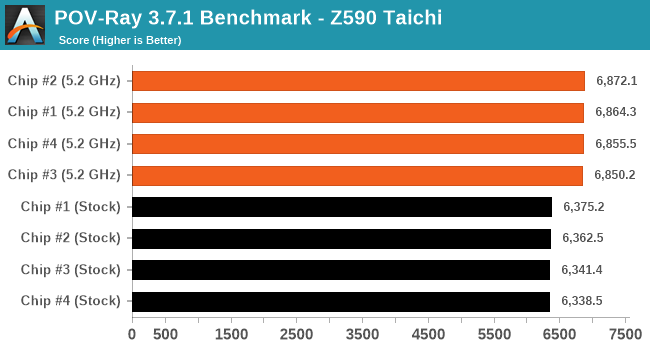

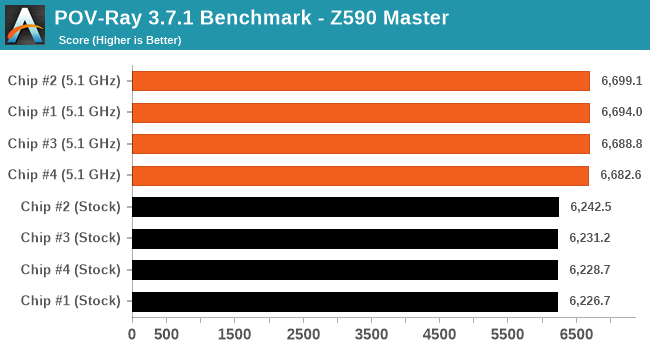
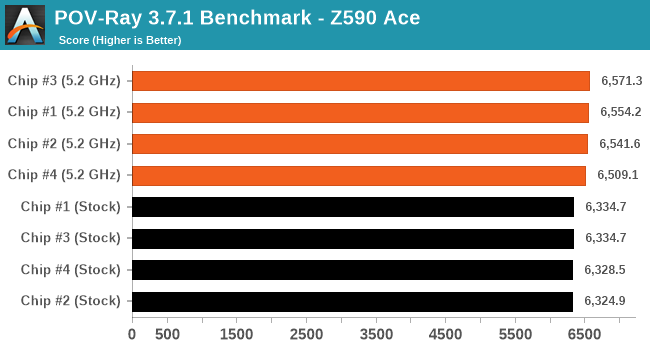
In our POV-Ray testing, all four of the processors on each board managed to beat default performance convincingly with an average increase of 6.4%.
Rendering - Cinebench R23: Link
Maxon's real-world and cross-platform Cinebench test suite has been a staple in benchmarking and rendering performance for many years. Its latest installment is the R23 version, which is based on its latest 23 code which uses updated compilers. It acts as a real-world system benchmark that incorporates common tasks and rendering workloads as opposed to less diverse benchmarks which only take measurements based on certain CPU functions. Cinebench R23 can also measure both single-threaded and multi-threaded performance.
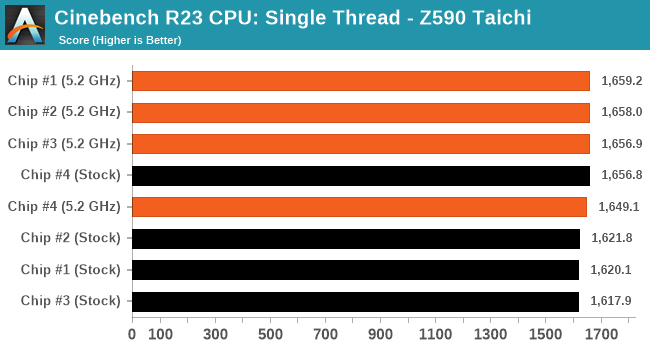
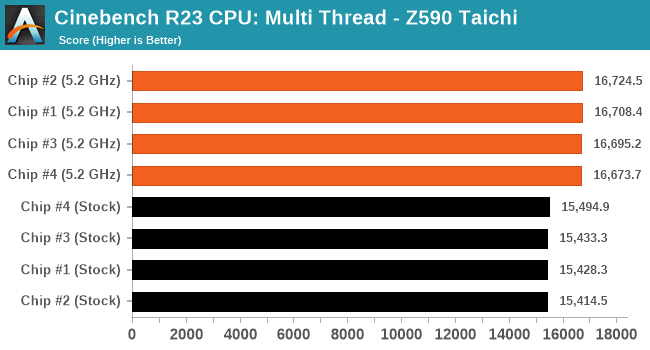
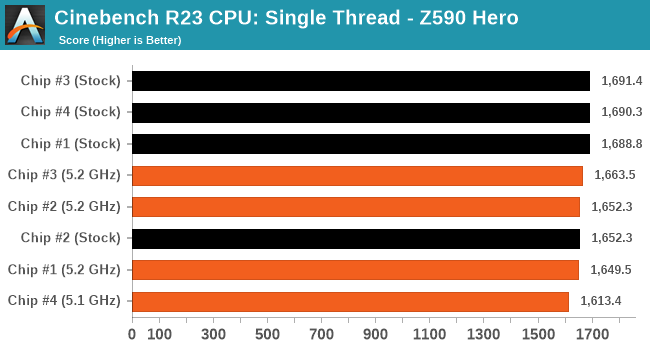
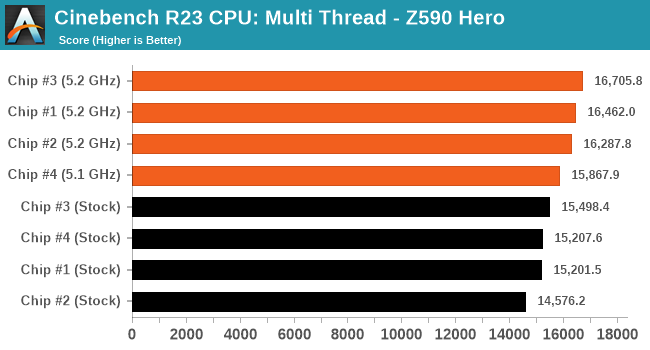
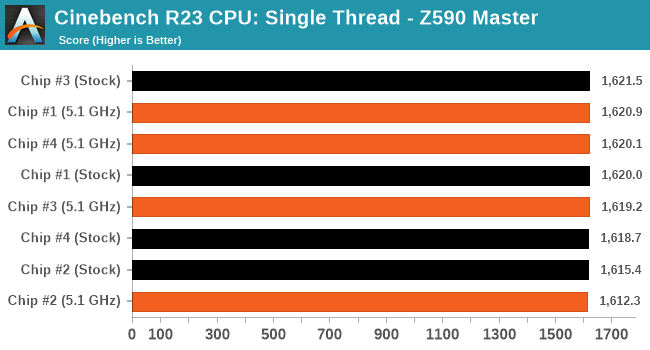
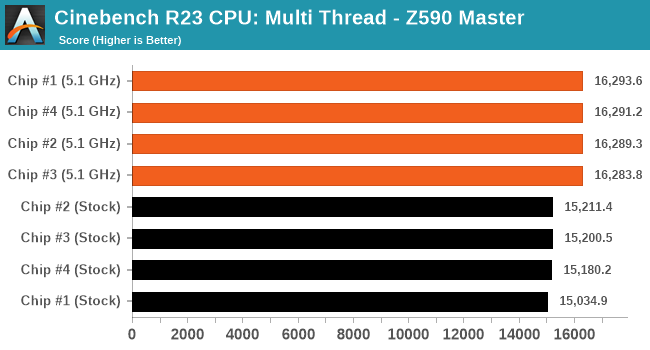
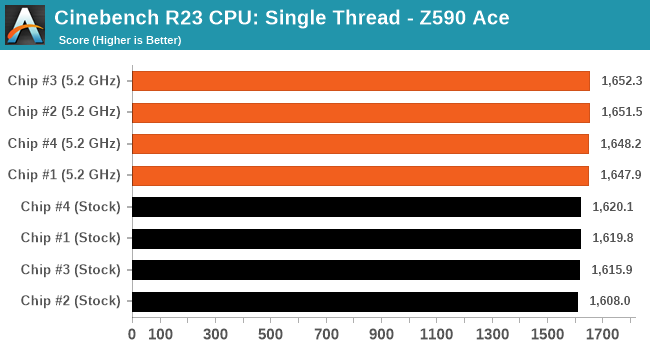

In CineBench R23, we saw a marginal uplift in performance in single-thread performance on average, but the biggest gains were in the multi-thread test with an average increase of 6% over default values. In perspective, the single-threaded performance gains in CB23 were around 0.04%. The reason why the ST values aren't popping here is because the stock CPU enables turbo with TVB to 5.3 GHz, whereas we are fixing each chip to 5.2 GHz all-core.










54 Comments
View All Comments
StevoLincolnite - Monday, August 30, 2021 - link
I just upgraded from my 10~ year old Core i7 3930K Sandy Bridge CPU, 6-cores, 12 threads. Overclocked to 4.6Ghz with 16Gb of Quad-Channel Ram...Haven't noticed much of a difference when upgrading to the Ryzen 9 5900X and 64GB of 3600Mhz Ram in the games I play. (Mostly just eSports titles)
But hoping this rig lasts 10~ years like my last one.
Sold my old system in parts and so far made about $1,000 AUD back, which is definitely a good return on investment... Enough to buy a Radeon RX 6700XT.
lemurbutton - Monday, August 30, 2021 - link
Buy Apple Silicon. Pretty soon, no amount of energy-wasting, environmentally unfriendly overclocks can match the speed of a 35w Apple Silicon thin and light Macbook Pro.TheinsanegamerN - Monday, August 30, 2021 - link
> suggesting an apple ARM device for the enviroment.My sides have entered hyperspace. How can one be so dense?
bigvlada - Monday, August 30, 2021 - link
That's what we were hearing about slow and melting Pentium 66 MHz and lightning fast and cool 90 MHz PowerMac.And no, "This time it will be different tm" won't work, because just like in 1984. and 1994. majority of people do not want a closed, barely repairable system. In those early days, you needed a bayonet sized screwdriver and soldering iron in order to expand memory on Apple machines.
joelypolly - Monday, August 30, 2021 - link
I mean... look at the smartphone market. It's a good indication that the market has changed and most people are just looking for a computing appliance.M O B - Monday, August 30, 2021 - link
Oh really. Do people normally want to swap out the GPU, RAM, disk, or WiFi/BT card in their android phone? Of course now. Phones, despite their computational power, are not computers. You fail at analogy.Every company except Apple at least makes it possible to swap out several components, granted that soldered RAM or PCIe SSDs are common in certain compact form factors.
vshade - Tuesday, August 31, 2021 - link
Smartphones are computers for most of the world, is the device they will communicate, make planning and game on.whatthe123 - Monday, August 30, 2021 - link
It's an indication of an entirely new premium market that relies on subscriptions to mask costs. Macs continue to dominate in profitability but they always trail in marketshare because the upfront costs are too high, and nobody can really even get that market except Apple since Apple is the only one that has successfully created and maintained a lifestyle culture around their products. In order for Apple's CPUs to sweep the rest of the market they'd need to sell their chips directly or macs would need to overtake everything else in volume, neither of which Apple seems interested in doing or is really able to do since they're capped by TSMC's output.Exotic - Tuesday, August 31, 2021 - link
On Desktop I agree as people generally want easy upgradability. Where Apple Sillicon will shine and be very impressive to a lot people will be in laptops. In 99.99% of laptops the CPU and GPU is soldered and is not user upgradeable and the same is to said for ultrabooks regarding RAM as that too is getting soldered onto the mainboard.Laptops also sell more than desktops these days.
Wrs - Tuesday, August 31, 2021 - link
Being closed and barely repairable is a side effect of tight integration, not necessarily with being Apple. It is true that Apple tends to be associated with pushing the curve on engineering/miniaturization and naturally this results in a higher price, but they don't have a monopoly on integration and neither does the PC side have a monopoly on expansion and the use of commodity parts.I remember Macs from the 90s, as well as Mac Minis in the 2010s that incorporated tool less entry to the RAM slots, and with just a few regular screws you can access the same on Intel iMacs. Hard drives were just more screws. That's leaving aside the Mac Pro lineup. Yet no modern smartphone lets you upgrade the RAM or internal storage because it takes a lot more effort to design user serviceability into such a tiny yet functional form factor.